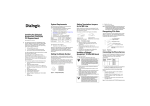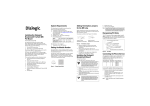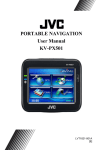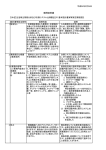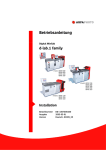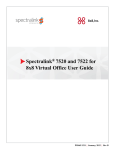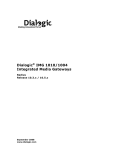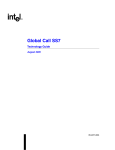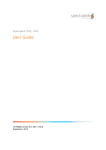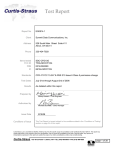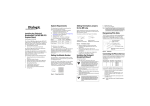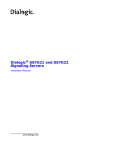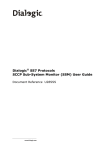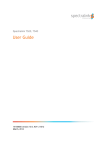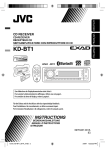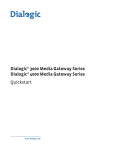Download Issue 7 - Dialogic
Transcript
Dialogic® SPCI2S and SPCI4 Boards User Manual www.dialogic.com Copyright© 2000-2007 Dialogic Corporation. All Rights Reserved. You may not reproduce this document in whole or in part without permission in writing from Dialogic Corporation at the address provided below. All contents of this document are subject to change without notice and do not represent a commitment on the part of Dialogic Corporation or its subsidiaries. Reasonable effort is made to ensure the accuracy of the information contained in the document. However, due to ongoing product improvements and revisions, Dialogic Corporation and its subsidiaries do not warrant the accuracy of this information and cannot accept responsibility for errors or omissions that may be contained in this document. INFORMATION IN THIS DOCUMENT IS PROVIDED IN CONNECTION WITH DIALOGIC® PRODUCTS. NO LICENSE, EXPRESS OR IMPLIED, BY ESTOPPEL OR OTHERWISE, TO ANY INTELLECTUAL PROPERTY RIGHTS IS GRANTED BY THIS DOCUMENT. EXCEPT AS EXPLICITLY SET FORTH BELOW OR AS PROVIDED IN A SIGNED AGREEMENT BETWEEN YOU AND DIALOGIC, DIALOGIC ASSUMES NO LIABILITY WHATSOEVER, AND DIALOGIC DISCLAIMS ANY EXPRESS OR IMPLIED WARRANTY, RELATING TO SALE AND/OR USE OF DIALOGIC PRODUCTS INCLUDING LIABILITY OR WARRANTIES RELATING TO FITNESS FOR A PARTICULAR PURPOSE, MERCHANTABILITY, OR INFRINGEMENT OF ANY INTELLECTUAL PROPERTY RIGHT OF A THIRD PARTY. Dialogic products are not intended for use in medical, life saving, life sustaining, critical control or safety systems, or in nuclear facility applications. It is possible that the use or implementation of any one of the concepts, applications, or ideas described in this document, in marketing collateral produced by or on web pages maintained by Dialogic Corporation or its subsidiaries may infringe one or more patents or other intellectual property rights owned by third parties. Dialogic Corporation and its subsidiaries do not provide any intellectual property licenses with the sale of Dialogic products other than a license to use such product in accordance with intellectual property owned or validly licensed by Dialogic Corporation or its subsidiaries. More detailed information about such intellectual property is available from Dialogic Corporation’s legal department at 9800 Cavendish Blvd., 5th Floor, Montreal, Quebec, Canada H4M 2V9. The software referred to in this document is provided under a Software License Agreement. Refer to the Software License Agreement for complete details governing the use of the software. Dialogic Corporation encourages all users of its products to procure all necessary intellectual property licenses required to implement any concepts or applications and does not condone or encourage any intellectual property infringement and disclaims any responsibility related thereto. These intellectual property licenses may differ from country to country and it is the responsibility of those who develop the concepts or applications to be aware of and comply with different national license requirements. Dialogic, Dialogic Pro, Brooktrout, Cantata, SnowShore, Eicon, Eicon Networks, Eiconcard, Diva, SIPcontrol, Diva ISDN, TruFax, Realblocs, Realcomm 100, NetAccess, Instant ISDN, TRXStream, Exnet, Exnet Connect, EXS, ExchangePlus VSE, Switchkit, N20, Powering The Service-Ready Network, Vantage, Connecting People to Information, Connecting to Growth and Shiva, among others as well as related logos, are either registered trademarks or trademarks of Dialogic. Dialogic's trademarks may be used publicly only with permission from Dialogic. Such permission may only be granted by Dialogic’s legal department at 9800 Cavendish Blvd., 5th Floor, Montreal, Quebec, Canada H4M 2V9. Any authorized use of Dialogic's trademarks will be subject to full respect of the trademark guidelines published by Dialogic from time to time and any use of Dialogic’s trademarks requires proper acknowledgement. Windows is a registered trademark of Microsoft Corporation in the United States and/or other countries. Other names of actual companies and products mentioned herein are the trademarks of their respective owners. Publication Date: December 2007 Document Number: U04HSP, Issue 7 2 Dialogic® SPCI2S and SPCI4 Boards User Manual Issue 7 Contents Revision History ...........................................................................................................5 1 Warnings and Cautions .......................................................................................7 2 Introduction ........................................................................................................9 2.1 2.2 2.3 2.4 2.5 Purpose .................................................................................................................................9 Overview ...............................................................................................................................9 Hardware Overview............................................................................................................... 10 System Requirements ........................................................................................................... 10 Related Documentation.......................................................................................................... 10 3 Product Specification ........................................................................................ 13 3.1 3.2 3.3 3.4 3.5 3.6 3.7 3.8 3.9 PCM Interface Ports............................................................................................................... 13 PCM Highway ....................................................................................................................... 13 SS7 Serial Interface Ports (SPCI2S) ........................................................................................ 13 Signaling Interface................................................................................................................ 13 Processor System ................................................................................................................. 13 Physical ............................................................................................................................... 14 Environmental ...................................................................................................................... 14 Power requirements .............................................................................................................. 14 Reliability............................................................................................................................. 14 4 Regulatory Specifications and Declarations....................................................... 15 4.1 4.4 Specifications Demonstrating Compliance ................................................................................ 15 4.1.1 Safety Compliance .................................................................................................... 15 4.1.2 Electromagnetic Compatibility (EMC)........................................................................... 15 4.1.3 Telecommunications Compliance ................................................................................ 15 Declarations of the Manufacturer or Importer ........................................................................... 16 4.2.1 CE Declaration of Conformity – European Economic Area ............................................... 17 4.2.2 FCC Part 15 Electromagnetic Compliance Statement -USA ............................................. 19 4.2.3 FCC Part 68 Statement - USA..................................................................................... 20 4.2.4 Telecommunications Attachment Notice - Canada ......................................................... 21 4.2.5 ICES-003 Electromagnetic Compatibility Notice - Canada............................................... 21 4.2.6 Telecommunications Notice – Australia / New Zealand .................................................. 21 Essential Compliance Information ........................................................................................... 22 4.3.1 Safety .......................................................................................................... 22 4.3.2 USA and Canada Specific Safety aspects ..................................................................... 22 4.3.3 EMC .......................................................................................................... 22 4.3.4 Telecommunications ................................................................................................. 23 Product Environmental Information ......................................................................................... 24 5 Hardware Installation ....................................................................................... 27 5.1 5.2 5.3 5.4 5.5 5.6 5.7 Warnings and Cautions .......................................................................................................... 27 Unpacking............................................................................................................................ 27 Identification ........................................................................................................................ 27 Host Specific Installation Aspects ............................................................................................ 28 Switch and Link Settings........................................................................................................ 28 Software License Button ........................................................................................................ 28 Physical Installation .............................................................................................................. 29 6 Interfaces ......................................................................................................... 31 6.1 6.2 User LEDs ............................................................................................................................ 31 H.100 CT Bus ....................................................................................................................... 31 4.2 4.3 3 Contents 6.3 6.4 PCM Interface Ports .............................................................................................................. 31 SS7 Serial Interface Ports (SPCI2S) ........................................................................................ 32 7 Part Number Reference .....................................................................................35 Index ...............................................................................................................37 Figures Figure 1. Figure 2. Figure 3. Creepage and Clearance Distances ............................................................................ 24 SPCI4 Connector Positions ........................................................................................ 31 SPCI2S Connector Positions ...................................................................................... 32 Tables Table 1. Table Table Table Table Table Table 4 2. 3. 4. 5. 6. 7. Voltage Used or Generated by Other Clearance Parts of the Host, Including Other Boards or Assemblies ............................................................................................................. 24 License Button Symbols............................................................................................ 28 PCM Interface Ports Connector Pin-Out....................................................................... 32 SS7 Serial Interface Ports (Dual V.11) Connector Pin-Out (SPCI2S) ............................... 33 Board Products of Equipment Type SPCI ..................................................................... 35 Software License Buttons for SPCI Board-based Protocols............................................. 35 Software Licenses for Host-based Protocols for use with SPCI Boards............................. 35 Dialogic® SPCI2S and SPCI4 Boards User Manual Issue 7 Revision History Issue Date Changes A 20-Jul-00 Initial release of User Manual to accompany pre-production evaluation boards. B 01-Mar-01 Added details of switch and link settings. 01 26-Jul-01 Added appendices on safety and EMC. 02 11-Sep-02 Additional regulatory information. Change branding. 03 19-Sep-02 Incorporate IDoC. Revised reliability data. 04 20-May-05 IDoC revised, and the editions of some EMC specifications. Additional EU language declarations. Corrected FCC Part 15 statement. Australia/New Zealand regulatory information included. 05 14-Jul-06 Introduction of Ordering Codes information. Revisions to Safety Specification editions and IDoC. 06 draft Revision of EMC specifications 07 Dec 2007 Reformat and re-brand Note: The latest release issue of this guide can be found at: http://www.dialogic.com/support/helpweb/signaling 5 Revision History 6 Dialogic® SPCI2S and SPCI4 Boards User Manual Issue 7 1 Warnings and Cautions WARNING TELECOMMUNICATIONS NETWORK CONNECTION: The telecommunication interfaces of these Products are not intended for direct connection to “outside plant” signal conductors (metallic). The Products shall be isolated, by channel banks or office repeaters, from any connections to network or terminal equipment, that lie outside of the same building. The telecommunication interface connections are considered to be, and meet the requirements of, SELV circuits (not TNV). The cables connecting to them shall be kept apart from any cables of TNV circuits. Refer also to any region specific regulatory requirements of network connection in Section 4 Regulatory Specifications and Declarations on page 15. WARNUNG [Deutsch] TELEKOMMUNIKATIONSNETZWERKVERBINDUNG: Die Telekommunikationsschnittstellen dieser Produkte sind nicht für den direkten Anschluss an externe Signalleiter (Metall) geeignet. Die Produkte sollten durch Netzwerkabschlusseinheiten (z. B. Multiplexer, Regeneratoren) von sämtlichen Netzwerk- oder Terminal-Geräten isoliert werden, die sich außerhalb des gleichen Gebäudes befinden. Die Verbindungen über die Telekommunikationsschnittstelle entsprechen den Anforderungen für SELVSchaltkreise (nicht TNV). Die SELV-Verbindungskabel sollten von den TNVSchaltkreisen getrennt sein. Regionale Vorschriften für Netzwerkverbindungen finden Sie in Abschnitt Section 4 Regulatory Specifications and Declarations on page 15. CAUTION Anti-Static Handling Procedures: The Dialogic® SPCI2S and SPCI4 boards (“boards” or “products”) contain Electrostatic Sensitive Devices (ESDs), which may be permanently damaged if incorrectly handled. If boards are removed from the host computer they must be handled in accordance with appropriate anti-static handling procedures. Refer to: EN100015-1 Basic Specification: Protection of Electrostatic Sensitive Devices: Part 1 General Requirements for further details. Hold boards only by their edges. After removing a board from its protective wrapper or from a host computer, place it on a grounded surface free of static electricity. Do not slide boards over any surface. ACHTUNG [Deutsch] Durch elektrostatische Entladung können Zusatzkarten/-module beschädigt werden. Wenn Module aus dem Gehäuse entfernt werden, muß das im Einklang mit EN 100-015 Teil 1 Allgemeine Bestimmungen geschehen. 7 Section 1 Warnings and Cautions CAUTION Temperature: The temperature in which these products operate, when installed in a host computer, must not go below 0 °C (32 °F) or rise above 55 °C (131 °F). Extreme fluctuations in temperature can cause a variety of problems in your products. 8 Dialogic® SPCI2S and SPCI4 Boards User Manual Issue 7 2 Introduction 2.1 Purpose This document is a User Manual that addresses the Hardware aspects of the Dialogic® SPCI2S and Dialogic® SPCI4 products. These products are SS7 Signaling Boards in PCI form factor. Collectively, the two board variants may be referred to as Equipment Type SPCI. The full Product IDs (ordering codes) for the two variants are SS7SPCI2SQ and SS7SPCI4Q, although in this User Manual, and many other documents, they are commonly known as SPCI2S and SPCI4. This User Manual includes the specification of the products and a functional description. It details all the interface connections, including pin-out, and provides installation instructions. It should be read in conjunction with the Dialogic® SS7 Boards Programmer’s Manual for SPCI2S and SPCI4 ∗ which gives further information on the use of the boards, including a description of configuration parameters and commands. 2.2 Overview The SPCI2S and SPCI4 boards are intelligent multi-port SS7 signaling interface boards capable of use in a telecommunications environment. Embedded software support for many signaling systems is available including the entire Signaling System Number 7 (SS7) protocol stack. The SPCI4 board supports up to four primary rate telecommunications interfaces; each can individually be configured at run-time under software control to operate as an E1, T1 or J1 interface. The SPCI2S board supports up to two primary rate telecommunications interfaces, but also supports up to two synchronous V.11 (V.35 compatible) serial interfaces. The on-board H.100 Computer Telephony (CT) Bus interface and digital switch allows timeslots to be routed between the E1/T1/J1 interfaces, the H.100 CT Bus and the on-board signaling processors. This enables bearer (voice) circuits to be routed to other resource boards and permits flexible routing of signaling timeslots through the system. A signaling processor provides support for multiple HDLC-based signaling channels including up to 4 SS7 signaling links. The signaling links may be presented either as a timeslot on an external PCM interface, as a timeslot on the CT Bus, or as a synchronous V.11 (V.35 compatible) serial interface. Signaling links can all operate at 64kbit/s, 56kbit/s or 48kbit/s. Software downloaded to the board at run-time implements the signaling protocol and provides a message-based interface to the user's application software running on the host computer. Software for several signaling systems is available, including the following SS7 protocols: MTP, ISUP, TUP, SCCP, TCAP, MAP, IS41 and INAP. Software drivers for the board are available for many host operating systems, including: Microsoft Windows® 2000, Windows® XP, Linux and Solaris. ∗ Document number U03HSP. 9 Section 2 2.3 Introduction Hardware Overview The SPCI2S and SPCI4 boards are full length PCI boards with 33MHz 32 bit PCI interface. The boards are Universal expansion boards capable of detecting the host signaling environment in use and adapting themselves to either +5V or +3.3V signaling environments. Note: The distinction is the signaling protocol used and not the power rail to which board connects. Each board has an H.100 CT Bus interface, which is used to provide connectivity to further boards or to other H.100 CT Bus compatible boards, such as voice processing and fax cards. The H.100 CT Bus supports 4096 channels (or timeslots) and the associated clock and framing signals. Each board is capable of generating the CT Bus clocks, or can act as a slave. CT Bus channels may be used individually or can be grouped to provide a higher bandwidth data path. The signals are carried between boards in a host computer using an H.100 CT Bus ribbon cable. 2.4 System Requirements To use the SPCI2S or SPCI4 signaling board, the host computer must meet the following minimum specifications: 2.5 • This signaling board is for use only with UL listed computers that have installation instructions detailing user installation of card cage accessories. • Rev. 2.1 PCI compliant computer system. • One free 33MHz 32 bit PCI full size expansion slot. Related Documentation • U03HSP - SS7 Boards Programmer’s Manual for SPCI2S and SPCI4 This document provides further information on the use of the board. • 05-2300 - SS7G21 and SS7G22 Signaling Server Hardware Manual This document provides full instructions on installing the board into Dialogic® SS7G21 Signaling Server products. • ECTF H.100 Hardware Compatibility Specification: CT Bus This document provides further information on the H.100 CT Bus. This document may be obtained from the ECTF web site: http://www.ectf.org • PCI local bus specification Rev. 2.1 This document provides further information on the PCI bus. It may be obtained from the PCI-SIG web site: http://www.pcisig.com 10 Dialogic® SPCI2S and SPCI4 Boards User Manual Issue 7 For current software and documentation supporting SPCI products, visit: http://www.dialogic.com/support/helpweb/signaling/ For the Dialogic® SPCI2S and SPCI4 boards product data sheet, visit: http://www.dialogic.com/products/list.asp For more information on Dialogic® SS7 products and solutions, visit: http://www.dialogic.com/support/helpweb/signaling/ 11 Section 2 12 Introduction Dialogic® SPCI2S and SPCI4 Boards User Manual Issue 7 3 Product Specification 3.1 PCM Interface Ports Ports: 2 (SPCI2S) 4 (SPCI4) 3.2 3.3 3.4 3.5 Data rate: 2048 kbit/s (E1) or 1544 kbit/s (T1/J1) software selectable for each individual port Connector: RJ45 Pulse shape: ITU-T G.703, AT&T TR62411 Frame format: E1, E1-CRC4, D4, ESF Line code: HDB3, AMI (ZCS), AMI, B8ZS PCM Highway Bus type: H.100 CT Bus Clock rate: 8192 kHz Connector: Edge connector Clocking: Master or Slave SS7 Serial Interface Ports (SPCI2S) Connector: 26 pin High density D-type female shared between both ports Electrical: V.11 (V.35 compatible) Signals: Tx Clock, Rx Clock, Tx Data, Rx Data Data Rate: 48kbit/s, 56 kbit/s, 64 kbit/s or external Signaling Interface Source: PCM Interface, H.100 or SS7 Serial Interface Data Rate: 48kbit/s, 56 kbit/s, 64 kbit/s Timeslot: Fully programmable Processor System Processor: MPC860 Clock rate: 50MHz RAM: 32 Mbyte Synchronous DRAM Bus interface: 33 MHz 32 bit PCI Rev. 2.1 13 Section 3 3.6 Product Specification Physical Height: 106mm Length: 341mm Width: Single slot PCI board Weight: 211 grams (SPCI2S) 180 grams (SPCI4) 3.7 3.8 Environmental Operating temperature: 0°C to +55°C Storage temperature: -40°C to +70°C Humidity: 0 to 95% non-condensing Altitude: 0 to 3,500m Power requirements +5V ±5%: 3.9 Reliability MTBF: 14 1.5A Typical, 2A Maximum 204,000 hours Bellcore† Method @ 40°C Dialogic® SPCI2S and SPCI4 Boards User Manual Issue 7 4 Regulatory Specifications and Declarations 4.1 Specifications Demonstrating Compliance 4.1.1 Safety Compliance USA: UL Listed to U.S. and Canadian safety standards. File number E310851 Canada: UL/CSA 60950-1 – 1st Edition – 2003 Europe: EN 60950-1: 2001 + A11: 2004 including National deviations Australia: AS/NZS 60950.1: 2003 for national variations to IEC (below) New Zealand: International: 4.1.2 CB Certificate to IEC 60950-1: 1st Edition (2001) + Corrigendum 1 (2002), with National and group differences according to CB Bulletin No 109A Electromagnetic Compatibility (EMC) USA: FCC, 47 CFR, Part 15, Subpart B - Unintentional Radiators, verified Class A digital device Canada: ICES-003 Issue 4 – Feb 2004 - Class A, Digital Apparatus Europe: EN 300 386 V1.3.3 (2005-04) EMC + ERM, Telecommunication Network Equipment EN 55022: 1998, Class A Limits, ITE Radiated & Conducted Emissions EN 55024: 1998 +A1 +A2, ITE Immunity Characteristics EN 61000-4-2, ESD Immunity EN 61000-4-3, Radiated Immunity EN 61000-4-4, Electrical Fast Transients/Bursts EN 61000-4-6, Conducted RF Immunity EN 61000-4-8, Power Frequency Magnetic Fields EN 61000-4-11, Voltage Dips and Interrupts Australia: 4.1.3 New Zealand: EN 300 386 V1.3.3 (2005-04) EMC + ERM, Telecommunication Network Equipment International: CISPR 22 Ed 4.0 (2003-04), Class A Limit Telecommunications Compliance USA: TIA/EIA-IS-968 – July 2001 and TIA/EIA/TSB-168 FCC Part 68 rules as adopted by ACTA, interface classified as an “XD” terminal device (T1 DSX-1 type). ACTA Product-Labeling number: US: ICKCNNANSS7SPCI Canada: Industry Canada CS-03 Issue 8 – A7 July 2004, Part II Registered number: IC: 885F-SS7SPCI Europe: ETSI TBR 12 Business TeleCommunications (BTC); Open Network Provision (ONP) technical requirements; 2048 kbit/s digital unstructured leased lines (D2048U); Attachment requirements for terminal equipment interface ETSI TBR 13 Business TeleCommunications (BTC); 2048 kbit/s digital structured leased lines (D2048S); Attachment requirements for terminal equipment interface 15 Section 4 4.2 Regulatory Specifications and Declarations Declarations of the Manufacturer or Importer The International Declaration of Conformity for this product is copied below, or can be downloaded from: http://www.dialogic.com/declarations 16 Dialogic® SPCI2S and SPCI4 Boards User Manual Issue 7 4.2.1 CE Declaration of Conformity – European Economic Area The Products carry the CE mark Hereby, Dialogic Corporation, declares that the Dialogic® SPCI2S and SPCI4 products are in compliance with the essential requirements and other relevant provisions of European Union Directives 1999/5/EC (R&TTE), 89/336/EEC (EMC Directive) and 2006/95/EC (Low Voltage Directive). Manufacturer’s office in European Union: Dialogic Distribution Limited, Unit 4034 Kingswood Avenue, Citywest Business Campus, Saggart, Co Dublin, Ireland To achieve CE compliance, be sure to select a host computer that already meets the EMC and Low Voltage Directives before the addition of any optional board. Remember that the use of option boards declared compliant with the Directives by their manufacturer only gives "presumption of compliance" for the whole system. It is the responsibility of the system supplier to verify that the requirements of the listed Directives are still met by the final system, as supplied to an end-user. [Česky] Dialogic Corporation tímto prohlašuje, že tento SPCI2S, SPCI4 je ve shode se základními požadavky a dalšími príslušnými ustanoveními smernice 1999/5/ES, 89/336/EHS, 2006/95/ES. [Dansk] Undertegnede Dialogic Corporation erklærer herved, at følgende udstyr SPCI2S, SPCI4 overholder de væsentlige krav og øvrige relevante krav i direktiv 1999/5/EF, 89/336/EØF, 2006/95/EF. [Deutsch] Hiermit erklärt Dialogic Corporation, dass sich das Gerät SPCI2S, SPCI4 in Übereinstimmung mit den grundlegenden Anforderungen und den übrigen einschlägigen Bestimmungen der der Richtlinie 1999/5/EG, 89/336/EWG, 2006/95/EG befindet". [Eesti] Käesolevaga kinnitab Dialogic Corporation seadme SPCI2S, SPCI4 vastavust direktiivi 1999/5/EÜ, 89/336/EMÜ, 2006/95/EÜ, põhinõuetele ja nimetatud direktiivist tulenevatele teistele asjakohastele sätetele. [Español] Por medio de la presente Dialogic Corporation declara que el SPCI2S, SPCI4 cumple con los requisitos esenciales y cualesquiera otras disposiciones aplicables o exigibles de la Directiva 1999/5/CE, 89/336/CEE, 2006/95/CE 17 Section 4 Regulatory Specifications and Declarations [Ελληνική] ΜΕ ΤΗΝ ΠΑΡΟΥΣΑ Dialogic Corporation ΔΗΛΩΝΕΙ ΟΤΙ SPCI2S, SPCI4 ΣΥΜΜΟΡΦΩΝΕΤΑΙ ΠΡΟΣ ΤΙΣ ΟΥΣΙΩΔΕΙΣ ΑΠΑΙΤΗΣΕΙΣ ΚΑΙ ΤΙΣ ΛΟΙΠΕΣ ΣΧΕΤΙΚΕΣ ΔΙΑΤΑΞΕΙΣ ΤΗΣ ΟΔΗΓΙΑΣ 1999/5/ΕΚ, 89/336/EOK, 2006/95/EK. [Français] Par la présente Dialogic Corporation déclare que l'appareil SPCI2S, SPCI4 est conforme aux exigences essentielles et aux autres dispositions pertinentes de la directive 1999/5/CE, 89/336/CEE, 2006/95/CE. [Italiano] Con la presente Dialogic Corporation dichiara che questo SPCI2S, SPCI4 è conforme ai requisiti essenziali ed alle altre disposizioni pertinenti stabilite dalla direttiva 1999/5/CE, 89/336/CEE, 2006/95/CE. [Latviski] Ar šo Dialogic Corporation deklare, ka SPCI2S, SPCI4 atbilst Direktivas 1999/5/EK, 89/336/EEK, 2006/95/EK, butiskajam prasibam un citiem ar to saistitajiem noteikumiem. [Lietuvių] Šiuo Dialogic Corporation deklaruoja, kad šis SPCI2S, SPCI4 atitinka esminius reikalavimus ir kitas 1999/5/EB, 89/336/EEB, 2006/95/EB, Direktyvos nuostatas. [Magyar] Alulírott, Dialogic Corporation nyilatkozom, hogy a SPCI2S, SPCI4 megfelel a vonatkozó alapvetõ követelményeknek és az 1999/5/EK, 89/336/EGK, 2006/95/EK, irányelv egyéb elõírásainak. [Malti] Hawnhekk, Dialogic Corporation, jiddikjara li dan SPCI2S, SPCI4 jikkonforma mal-htigijiet essenzjali u ma provvedimenti ohrajn relevanti li hemm fidDirrettiva 1999/5/KE, 89/336/KEE, 2006/95/KE. [Nederlands] Hierbij verklaart Dialogic Corporation dat het toestel SPCI2S, SPCI4 in overeenstemming is met de essentiële eisen en de andere relevante bepalingen van richtlijn 1999/5/EG, 89/336/EEG, 2006/95/EG. [Polski] Niniejszym Dialogic Corporation oświadcza, że SPCI2S, SPCI4 jest zgodny z zasadniczymi wymogami oraz pozostałymi stosownymi postanowieniami Dyrektywy 1999/5/WE, 89/336/EWG, 2006/95/WE. 18 Dialogic® SPCI2S and SPCI4 Boards User Manual Issue 7 [Português] Dialogic Corporation declara que este SPCI2S, SPCI4 está conforme com os requisitos essenciais e outras disposições da Directiva 1999/5/CE, 89/336/CEE, 2006/95/CE. [Slovensko] Dialogic Corporation izjavlja, da je ta SPCI2S, SPCI4 v skladu z bistvenimi zahtevami in ostalimi relevantnimi določili direktive 1999/5/ES, 89/336/EGS, 2006/95/ES. [Slovensky] Dialogic Corporation týmto vyhlasuje, že SPCI2S, SPCI4 spĺňa základné požiadavky a všetky príslušné ustanovenia Smernice 1999/5/ES, 89/336/EHS, 2006/95/ES. [Suomi] Dialogic Corporation vakuuttaa täten että SPCI2S, SPCI4 tyyppinen laite on direktiivin 1999/5/EY, 89/336/ETY, 2006/95/EY oleellisten vaatimusten ja sitä koskevien direktiivin muiden ehtojen mukainen. [Svenska] Härmed intygar Dialogic Corporation att denna SPCI2S, SPCI4 står I överensstämmelse med de väsentliga egenskapskrav och övriga relevanta bestämmelser som framgår av direktiv 1999/5/EG, 89/336/EEG, 2006/95/EG. [Íslenska] Hér með lýsir Dialogic Corporation yfir því að SPCI2S, SPCI4 er í samræmi við grunnkröfur og aðrar kröfur, sem gerðar eru í tilskipun 1999/5/EC, 89/336/EEC, 2006/95/EC. [Norsk] Dialogic Corporation erklærer herved at utstyret SPCI2S, SPCI4 er i samsvar med de grunnleggende krav og øvrige relevante krav i direktiv 1999/5/EF, 89/336/EØF, 2006/95/EF. 4.2.2 FCC Part 15 Electromagnetic Compliance Statement -USA This equipment has been tested and found to comply with the limits for a Class A digital device, pursuant to Part 15 of the FCC Rules. These limits are designed to provide reasonable protection against harmful interference when the equipment is operating in a commercial environment. This equipment generates, uses, and can radiate radio frequency energy and, if not installed and used in accordance with the instructions, may cause harmful interference to radio communications. Operation of this equipment in a residential area is likely to cause harmful interference in which case, the user is required to correct the interference at their own expense. 19 Section 4 4.2.3 Regulatory Specifications and Declarations FCC Part 68 Statement - USA This equipment complies with Part 68 of the FCC rules and the requirements adopted by the ACTA. On the pcb of this equipment is a label that contains, among other information, an ACTA product-labelling number in the format US: AAAEQ##TXXXX. If requested, this number must be provided to the telephone company. For this equipment the Facilities Interface Code (FIC) may be 04DU9.BN , 04DU9.DN , 04DU9.1KN or 04DU9.1SN according to configuration of equipment, and the Service Order Code (SOC) is 6.0N. A plug and jack used to connect this equipment to the premises wiring and telephone network must comply with the applicable FCC Part 68 rules and requirements adopted by the ACTA. The T1 interface provided on this equipment is classified by the FCC as an “XD” terminal device (T1 DSX-1 type) and must be connected behind a registered CSU or PBX. If this equipment causes harm to the telephone network, the telephone company will notify you in advance that temporary discontinuance of the service may be required. But if advance notice isn't practical, the telephone company will notify the customer as soon as possible. Also, you will be advised of your right to file a complaint with the FCC if you believe it is necessary. The telephone company may make changes in its facilities, equipment, operations, or procedures that could affect the operation of the equipment. If this happens, the telephone company will provide advance notice in order for you to make necessary modifications to maintain uninterrupted service. To return a board for warranty repair or any other returns, please contact your Dialogic vendor from whom you purchased the board or Dialogic Technical Services and Support 1 . If the equipment is causing harm to the telephone network, the telephone company may request that you disconnect the equipment until the problem is resolved. The mounting of the approved unit in the final assembly must be made so that the approved unit is isolated from exposure to any hazardous voltages within the assembly. Adequate separation and restraint of cables and cords must be provided. The final assembler shall provide in the consumer instructions all applicable customer information. Telephone companies report that electrical surges, typically lightning transients, are very destructive to customer terminal equipment connected to AC power sources. The use of a surge arrestor on the AC line is recommended. In order for FCC registration of this product to be retained, all other products used in conjunction with this product to provide your telephony function must also be FCC Part 68 registered for use with CTBUS hosts. All Dialogic® CTBUS resource and network devices, which are FCC registered, are compatible and approved for use with each other. 1 See http://www.dialogic.com/support/contact/ for contact information. 20 Dialogic® SPCI2S and SPCI4 Boards User Manual Issue 7 Some non-Dialogic devices may be compatible and approved for use with CTBUS devices. In determining if your particular component device is appropriately approved, look for the FCC Registered number on all components and ensure that the classification code "CE" or "CN" is part of that number. Refer to the FCC registered number on this product as an example. Note: The non-Dialogic host or resource equipment used in conjunction with this product may bear an FCC Registered number with other than the "CE" or "CN" classification). Classification code "CN" is for devices that provide a network interface, and code "CE" is for devices that do not have a network interface. Therefore it is recommended that only other Dialogic® FCC Part 68 registered devices or other FCC Part 68 registered devices bearing the "CE" or "CN" Classification be used in providing your telephony function. If any of these components are not registered, then you are required to seek FCC Part 68 registration of the assembled equipment prior to connection to the telephone network. Part 68 registration specifies that you are required to maintain this approval and as such become responsible for the following: 4.2.4 • any component device added to your equipment, whether it bears component registration or not, will require that a Part 68 compliance evaluation is done and possibly that you have testing performed and make a modification filing to the FCC before that new component can be used; • any modification/update made by a manufacturer to any component device within your equipment, will require that a Part 68 compliance evaluation is done and possibly that you have testing performed and make a modification filing to the FCC before the new component can be used; • if you continue to assemble additional quantities of this compound equipment, you are required to comply with the FCC’s Continuing Compliance requirements. Telecommunications Attachment Notice - Canada This product meets the applicable Industry Canada technical specifications. 4.2.5 ICES-003 Electromagnetic Compatibility Notice - Canada This Class A digital apparatus complies with Canadian ICES-003. Cet appareil numérique de la classe A est conforme à La norme NMB-003 du Canada. 4.2.6 Telecommunications Notice – Australia / New Zealand The primary role of this product is as Telecommunications Network Equipment. The product is not considered to be Customer Equipment (CE). 21 Section 4 Regulatory Specifications and Declarations It is the responsibility of the system integrator or network operator to ensure that installations meet Telecommunication specifications in support of interconnect agreements. 4.3 Essential Compliance Information This section documents miscellaneous points that should be observed to ensure the proper and safe use of this product worldwide. 4.3.1 Safety Users of this product, and service personnel, must refer to the Safety information included in Section 1 Warnings and Cautions on page 7 and in the documentation of any host computer into which the board is to be installed. The SCPI2S and SPCI4 boards are approved for installation in a host computer, and with host attachments, which are covered by a relevant type approval of their own. It is a condition of approval that the power required by the host and the total of all adapter boards installed within the host environment, together with any auxiliary apparatus, does not exceed the power specification as stated in the Technical reference Manual of the host computer. The power required by this board is 1.5A typical, 2.0A maximum, @ +5V. It is not intended for this product to be installed in a home or residential environment. It is not intended for this product to be installed or operated in a stressful or inordinary environment such as industrial sites, medical applications, or in flammable/explosive environments. 4.3.2 USA and Canada Specific Safety aspects This SCPI2S and SPCI4 boards are for use only with UL listed computers that have installation instructions detailing user installation of card cage accessories. To comply with the relevant safety requirements in these countries, connection of this equipment to the public network MUST be via a UL listed channel service unit (i.e. the board must NOT be directly connected to the external public line). 4.3.3 EMC Installation of Cables In order to ensure that the EMC performance of the products meet regulatory requirements: Cables used for the PCM Interface Ports, marked L1 to L4, shall be twistedpair screened cables, grounded at both ends. Cables used for the SS7 Serial Interface Ports (SPCI2S), marked AUX, shall have the ferrite clamps, provided with the product, installed close to the connector backshell. 22 Dialogic® SPCI2S and SPCI4 Boards User Manual Issue 7 Further Information Refer also to any region specific information on EMC (Sections 4.2.2 on page 19 and 4.2.5 on page 21). For further information on good EMC practice, the installer should consult the IEC61000-5-x series of Technical Reports on the subject of Electromagnetic Compatibility (EMC) - Installation and Mitigation Guidelines. In particular the following sections are recommended; IEC61000-5-1 - General Considerations, IEC61000-5-2 - Earthing and Cabling, IEC61000-5-6 - Mitigation of External EM Influences. 4.3.4 Telecommunications The telecommunication interfaces of this product are described in Sections 3.1 on page 13 and 6.3 on page 31. They are primary rate telecommunications (PCM) interfaces, configurable as E1/T1/J1 interfaces, with selectable line code and frame format. For information on setting the product configuration consult the SS7 Boards Programmer’s Manual for SPCI2S and SPCI4 ∗ . The developer/installer must ensure that they are configured to give an implementation that complies with the services offered by the local Public Switch Telephone Network (PSTN) operator. Application developers implementing supplementary services at application level must ensure that their implementation complies with the services offered by the local Public Switch Telephone Network (PSTN) operator. In case of doubt, network specifications must be consulted. In the European Union, the R&TTE Directive imposes that each PSTN operator makes such specifications available. This product has been successfully tested against TBR12 and TBR13 when configured for E1 operation. Refer also to other region specific information on network connection (Sections 4.2.3 on page 20 and 4.2.4 on page 21). The telecommunication network interfaces of this product are not intended for direct connection to “outside plant” signal conductors (metallic). The product shall be isolated, by channel banks or office repeaters, from any connections to network or terminal equipment, that lie outside of the same building. The telecommunication interface connections are considered to be, and meet the requirements of, SELV circuits (not TNV). In order to maintain the host-independent approval for the network interface, it is essential that, when other option boards are introduced which use or generate a hazardous voltage (as defined in IEC/EN60950-1), the minimum creepage and clearance distances specified in Table 1 on page 24 are maintained. The board or assembly holding the network interface must be installed such that, with the exception of the connections to the host, clearance and creepage distances shown in the table below are maintained between the board or assembly holding the network interface, and any part of the host, including other option boards or assemblies. Failure to maintain these minimum distances will invalidate the approval. ∗ Document number U03HSP. 23 Section 4 Table 1. Regulatory Specifications and Declarations Voltage Used or Generated by Other Clearance Parts of the Host, Including Other Boards or Assemblies X mm Y mm 2.0 2.4 < 50 Vrms or Vdc 2.6 3.0 <125 Vrms or Vdc 4.0 5.0 <250 Vrms or Vdc 4.0 6.4 <300 Vrms or Vdc The above creepage distances apply in a normal office environment. In the presence of conductive pollution, or voltages greater than 300 V (rms or dc), or if you have any doubt, seek advice from a competent telecommunication safety engineer before the installation. Creepage and clearance distances can be checked by measuring between the adjacent parts as shown below. Clearance distance X is the shortest distance in air between two parts. Y is the length of the creepage path between the same two parts. Figure 1. 4.4 Creepage and Clearance Distances Product Environmental Information During August 2005, the European Union Directive on Waste Electrical and Electronic Equipment (2002/96/EC) and its amendment (2003/108/EC), collectively known as the WEEE Directive, came into force throughout most of the European Union. These Dialogic® products come within the scope of the WEEE Directive. We are confident that this product will provide you with many years of reliable service. Moreover, we are pleased to advise you that Dialogic warrants this product, as detailed in the user guide and provides a fee based repair service when the product is out of warranty. However, a time will come when the product will no longer meet your needs or will become un-economic to repair. It is at that stage that we ask for your cooperation in recycling this product in the spirit of the WEEE directive. 24 Dialogic® SPCI2S and SPCI4 Boards User Manual Issue 7 Dialogic has taken great care to minimise the environmental burden of this product by careful design and manufacturing it under an Environmental Management System, registered to ISO14001. The requirements of ISO14001 are similar to and as rigorous as the requirements of ISO9001, Quality Management Systems with which you may be more familiar. We ask you to help us to ensure that the environmental burden of this product is minimised when it is of no further use to you by recycling it. Please do not dispose of this product through municipal or general waste systems because it contains materials which can be economically recycled. Like all electrical and electronic equipment, including televisions and computers, it may contain small amounts of materials which could lead to environmental damage. To minimise any environmental damage we ask you to have this product recycled by: • Bringing it to the recycling collection point in your company. • Handing it into the store where you are purchasing the replacement. • Delivering it to a local bring-centre in your area. No charge can be imposed on you for this recycling service, in the European Union, as Dialogic has paid for recycling this product when it was placed on the market. These are requirements of the WEEE directive. We thank you in advance for you co-operation and working with Dialogic in protecting our environment. Please do not dispose of this product through municipal or general waste. Recycle it. 25 Section 4 26 Regulatory Specifications and Declarations Dialogic® SPCI2S and SPCI4 Boards User Manual Issue 7 5 5.1 Hardware Installation Warnings and Cautions Refer to Section 1 Warnings and Cautions and Section 4.3 Essential Compliance Information before commencing installation. Refer to any Warnings and Cautions and Compliance Information in the documentation supplied with the Host Computer before commencing installation. CAUTION The Dialogic® SPCI2S and SPCI4 boards contain Electrostatic Sensitive Devices (ESDs), which may be permanently damaged if incorrectly handled. If a board is removed from the host computer it must be handled in accordance with appropriate anti-static handling procedures. Refer to: EN100-015 Part 1 Basic Specifications: Protection of Electrostatic Sensitive Devices: Part 1 General Requirements for further details. 5.2 Unpacking The SPCI2S and SPCI4 boards are supplied in anti-static packaging, and should always be stored in its anti-static bag when not installed in a computer. Inspect the packaging for any signs of damage that may have occurred during transit. In the event of damaged or missing items notify both the carrier and the supplier immediately. 5.3 Identification Two labels are applied to the non-component side of the main board assembly. The smaller of these labels shows the serial number in barcode and alphanumeric formats. The larger label contains the following information: • Manufacturers name and country of origin • The Equipment Type [ET: SPCI] • The variant specific Product ID [SS7SPCI2SQ or SS7SPCI4Q] • ACTA Product-Labeling number • Industry Canada Registered number • Other approvals symbols and/or text 27 Section 5 5.4 Hardware Installation Host Specific Installation Aspects The instructions that follow provide all of the installation information specific to the board. Any information relating to the host computer will, of necessity, be general in nature. Always consult the documentation provided with the host for more details of these aspects. If the board is being installed in a Dialogic® SS7G21 product, either as an upgrade or a repair, then the relevant Hardware Manual provides full instructions ∗ , and should be used in preference to the remainder of Section 5 on page 27. 5.5 Switch and Link Settings The two switches, labeled ADDR (SW1) and BOOT (SW2), are set to 0 for normal operation. Alternative modes are detailed in the SS7 Boards Programmer’s Manual for SPCI2S and SPCI4∗. Boards at each end of the H.100 CT Bus must terminate the clock lines; this is achieved by fitting links (jumpers) at all 7 positions on the link field labeled CLK TERM (J3). For boards in a ‘middle’ (non-end) position, the links (jumpers) should be installed in an offset (open) state. All other link positions are for manufacturing purposes only and should not be fitted. 5.6 Software License Button All software running on the board is enabled by a removable software license button. This is a small metal can that resembles a battery and is fitted to a holder near the top of the board. Prior to installing the board the correct license button must be fitted. The license button is supplied in a separate package. Carefully insert it into the holder by sliding it under the clip. Ensure that both contacts of the holder make good contact with the license button. The software enabled by the license button is indicated by a symbol engraved in the top of the button casing, as listed in Table 2 below. For Product ID (ordering codes) for license buttons refer to Section 7. Table 2. License Button Symbols Symbol ∗ U03HSP – Dialogic 28 ® Description M2 MTP2 only M3 MTP (MTP2 and MTP3) T1 ISUP, TUP, MTP (Small) T2 ISUP, TUP, MTP (Regular) T4 ISUP, TUP, MTP (Large) XX For use in SS7G21, SIU520, SG430 systems only MM Multi-link MONITOR only SS7 Boards Programmer’s Manual for SPCI2S and SPCI4 Dialogic® SPCI2S and SPCI4 Boards User Manual Issue 7 5.7 Physical Installation Prior to installing SPCI2S or SPCI4 boards, it is necessary to power down the host computer and disconnect any network interfaces. Having ensured that all power is off/disconnected, select a vacant expansion slot (If in doubt, refer to your host manual for advice). If blanking plates are fitted, remove them by undoing the retaining screw at the top. Retain the blanking plates for possible future use. Align the board with the card guide and the slot in the computer and press home until fully inserted. Care should be taken to ensure correct alignment of the connector and card guide before final insertion to prevent damage. Once the board is fully inserted, secure the board with the retaining screw at the top. Reconnect the power and network interfaces, then switch on the host computer. Once the board is physically installed in your host, refer to the section on software installation in the Dialogic® SS7 Boards Programmer’s Manual for SPCI2S and SPCI4 ∗ . ∗ Document number U03HSP. 29 Section 5 30 Hardware Installation Dialogic® SPCI2S and SPCI4 Boards User Manual Issue 7 6 Interfaces This section details the interfaces present on the Dialogic® SPCI2S and SPCI4 products. 6.1 User LEDs Three general purpose red LEDs, labeled A, B and C, are available to the user application. Use of these LEDs is detailed in the Dialogic® SS7 Boards Programmer’s Manual for SPCI2S and SPCI4 ∗ . 6.2 H.100 CT Bus An H.100 CT Bus interface is provided to allow connection to other H.100 compatible boards. The H.100 CT Bus supports 4096 channels (or timeslots) and the associated clock and framing signals. This board is capable of generating the CT Bus clocks, or can act as a slave. CT Bus channels may be used individually, or grouped to provide a higher bandwidth data path. The signals are carried between boards in a host computer using an H.100 CT Bus ribbon cable. The position of the H.100 connector can be seen in Figure 2 below and Figure 3 on page 32. 6.3 PCM Interface Ports Figure 2. SPCI4 Connector Positions L ic e n c e B u tto n H .1 0 0 C o n n e c to r C L1 B A U ser LEDs ADDR BOOT J3 CLK TERM L2 L3 L4 Each board provides two (SPCI2S) or four (SPCI4) primary rate telecommunications (PCM) interfaces, each port being individually configured at run-time under software control to operate as balanced E1, T1 or J1 ports, with selectable line code and frame format. For information on setting port configurations consult the SS7 Boards Programmer’s Manual for SPCI2S and SPCI4∗. The E1/T1/J1 ports on the boards are Safety Extra Low Voltage, SELV – the apparatus connects to the outside network via network termination units (NT1). Use twisted-pair, screened cables, grounded at both ends, to ensure the EMC and error-free performance of the product. ∗ Document number U03HSP. 31 Section 6 Interfaces The connectors are 8-way RJ45, and are labeled L1 to L4 in Figure 2 on page 31 and on the product (L3 and L4 only for SPCI2S in Figure 3 below). The connector pin out and signal descriptions are shown in Table 3 below. Note that pin 1 is towards the top of the board for each RJ45 connector. Table 3. PCM Interface Ports Connector Pin-Out Pin No Direction 1 Input Receive 2 Input Receive 3 6.4 Function N/C 4 Output Transmit 5 Output Transmit 6 N/C 7 N/C 8 N/C SS7 Serial Interface Ports (SPCI2S) Figure 3. SPCI2S Connector Positions L ic e n c e B u tto n H .1 0 0 C o n n e c to r C AUX (V .1 1 ) V .1 1 S e ria l In te rfa c e B o ard B A U ser LEDs ADDR BOOT J3 CLK TERM L3 L4 Each SPCI2S board provides two synchronous SS7 Serial Interface Ports. Both ports are presented in a single 26 way female high density D-type connector, and use V.11 (V.35 compatible) electrical interface characteristics. The connector is labeled AUX in Figure 3 above and on the product. The connector pin-out and signal assignment is shown in Table 4 on page 33, which identifies the ports as A and B. The SS7 Serial Interface Ports on the SPCI2S board are designated as SELV. Install the ferrite clamp, provided with this product, on the SS7 Serial Interface Port cable, close to the connector backshell, to ensure the EMC performance of the product. The SS7 Serial Interface Port may be clocked either by an internally generated clock or by an externally applied clock. In both cases the same clock is used for both the Transmit data and the Receive data. For internal clock operation use the Transmit clock pins and make no connection to the Receive clock pins on the D-type connector. For external clock operation connect the clock source to the Receive clock pins on the Dtype connector and make no connection to the Transmit clock pins. 32 Dialogic® SPCI2S and SPCI4 Boards User Manual Issue 7 Table 4. SS7 Serial Interface Ports (Dual V.11) Connector Pin-Out (SPCI2S) Pin No Direction 1 Function Chassis ground 2 Output V.11 Transmit inverted clock Port B 3 Output V.11 Transmit clock Port B 4 Output V.11 Transmit inverted data Port B 5 Output V.11 Transmit true data Port B 6 Input V.11 Receive inverted clock Port B 7 Input V.11 Receive clock Port B 8 Input V.11 Receive inverted data Port B 9 Input V.11 Receive true data Port B 10 Signal ground 11 to 18 N/C 19 Output V.11 Transmit inverted clock Port A 20 Output V.11 Transmit clock Port A 21 Output V.11 Transmit inverted data Port A 22 Output V.11 Transmit true data Port A 23 Input V.11 Receive inverted clock Port A 24 Input V.11 Receive clock Port A 25 Input V.11 Receive inverted data Port A 26 Input V.11 Receive true data Port A 33 Section 6 34 Interfaces Dialogic® SPCI2S and SPCI4 Boards User Manual Issue 7 7 Part Number Reference The Product IDs shown in the Tables below may be used to place orders for these products. Table 5. Board Products of Equipment Type SPCI Product ID ® Dialogic SS7SPCI2SQ Description SS7 signaling PCI board supporting up to 4 SS7 links, 2 software-selectable T-1/E-1 interfaces and 2 V.11 interfaces ® Dialogic SS7SPCI4Q SS7 signaling PCI board supporting up to 4 SS7 links, 4 software-selectable T-1/E-1 interfaces Table 6. Software License Buttons for SPCI Board-based Protocols Product ID SS7 ISUP, TUP, MTP (Small) ® SS7 ISUP, TUP, MTP (Regular) ® SS7 ISUP, TUP, MTP (Large) ® For use in systems product Dialogic® SS7G21. Dialogic SS7SBPCIISTUPQ Dialogic SS7SBPCIISTUPLQ Dialogic SS7SBPCISYSQ Table 7. Description ® Dialogic SS7SBPCIISTUPSQ Software Licenses for Host-based Protocols for use with SPCI Boards Product ID Description ® SS7 INAP software ® SS7 IS41 (TIA-41, ANSI-41) software ® SS7 ISUP software ® SS7 MAP software ® SS7 MTP3 software ® SS7 SCCP connection-oriented software ® SS7 SCCP-CL software ® SS7 TCAP software ® SS7 TUP software Dialogic SS7SBHSTINAP Dialogic SS7SBHSTIS41 Dialogic SS7SBHSTISUP Dialogic SS7SBHSTMAP Dialogic SS7SBHSTMTP3 Dialogic SS7SBHSTSCCPCO Dialogic SS7SBHSTSCCPCL Dialogic SS7SBHSTTCAP Dialogic SS7SBHSTTUP 35 Section 7 36 Part Number Reference Dialogic® SPCI2S and SPCI4 Boards User Manual Issue 7 Index C Cautions, 7 D Document purpose, 9 Documentation, related, 10 H Hardware installation, 27 Cautions, 27 Host specific installation aspects, 28 Identification, 27 Physical installation, 29 Software license button, 28 Switch and link settings, 28 Unpacking, 27 Warnings, 27 I Interfaces, 31 H.100 CT Bus, 31 PCM Interface Ports, 31 SS7 Serial Interface Ports (SPCI2S), 32 User LEDs, 31 O Overview, 9 Hardware, 10 PCM highway, 13 PCM interface ports, 13 Physical, 14 Power requirements, 14 Processor system, 13 Reliability, 14 Signaling interface, 13 SS7 serial interface ports (SPCI2S), 13 R Regulatory specifications and declarations, 15 Compliance, 15, 22 EMC, 15, 22 Safety, 15, 22 Canada, 22 USA, 22 Telecommunications, 15, 23 Manufacturer, importer declarations, 16 Australia, Telecommunications Notice, 21 Canada ICES-003 Electromagnetic Compatibility Notice, 21 Telecommunications Attachment Notice, 21 Europe, CE Declaration of Conformity, 17 New Zealand, Telecommunications Notice, 21 USA FCC Part 15 Electromagnetic Compliance Statement, 19 FCC Part 68 Statement, 20 Product Environmental Information, 24 S System requirements, 10 P W Part Numbers, 35 Product specification, 13 Environmental, 14 Warnings, 7 37





































